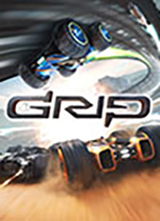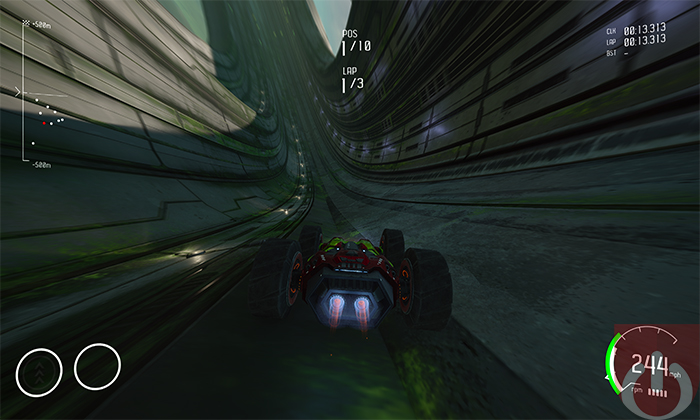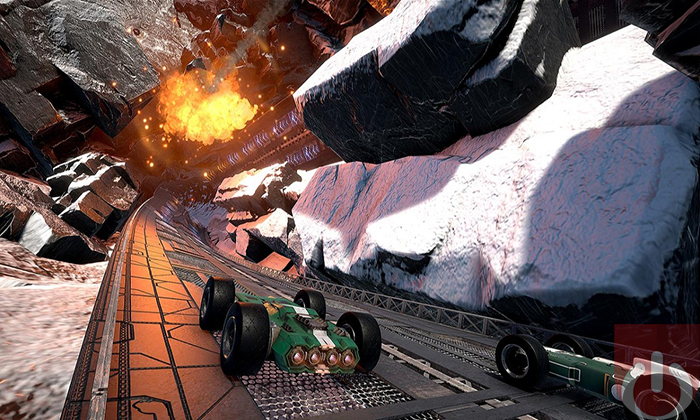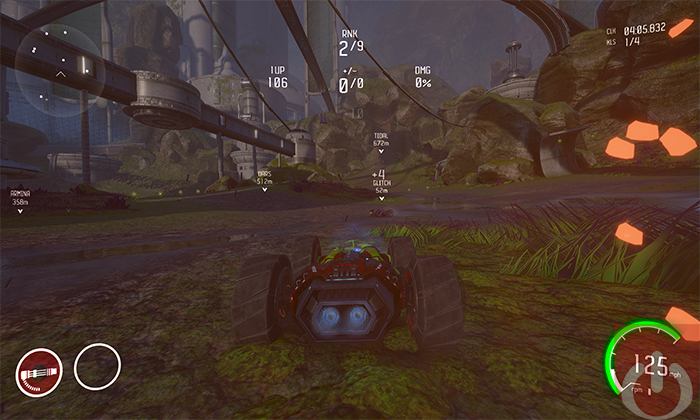GRIP: Combat Racing
I’ve already written about my love of the classic Psygnosis racer, Rollcage, and excitement over its return in the form of GRIP: Combat Racing. The game is finally out, although I’ve been playing GRIP since its early access days, which seems like years now. Just the same, this is a game that feels more at home on a console with big screen HDR 4KTV and surround sound speakers jacked up.
For those unfamiliar with GRIP’s pedigree, Rollcage (and it’s sequel, Stage 2) were PlayStation One sci-fi racers that defied gravity in an entirely different way than Wipeout. Racing what were essentially giant, four-wheel rocket-powered tanks, players could drive right up the walls and across the ceilings of tracks. It was hilarious, chaotic, and, thanks to an array of weapon power-ups, destructive. GRIP takes this exact same design and brings it to modern hardware.
Made by a small but dedicated group of fans and original Rollcage developers, GRIP is definitely an indie game – much more so than the original game, which was put out through Sony’s Psygnosis label. While there are a few issues with polish, this is still a thoroughly engaging and impressive racer. The core Rollcage gameplay is addictive, and the Unreal engine and far more powerful hardware of today’s systems allows GRIP to expand in every direction.
Tracks take place over a range of alien worlds, from deserts to urban sprawls, and most feel enormous. Offroad and on, GRIP tasks racers with speeding across cliff faces, through giant tubes, and across insane looping highways that are most closely related to something you’d find in Mario Kart. There are 22 tracks in total (plus one more released free on launch). Although if you’re playing through the beefy single-player tournament, it will take quite a while to see them all.
The single-player campaign is a surprisingly deep intro to the GRIP’s mechanics, modes, and features. With 11 ever-more difficult tiers, each with three tournaments of three events each, there’s hours of fun against the AI and clock before even getting to the multiplayer. Of course, you can also just try customized quick races and events outside the campaign like most racers.
Racing events are divided between pure speed-focused and weapons-based racing. For the latter, there are nine different offensive and defensive power-ups. Guided missiles, cluster rockets, machine guns, rear shields, speed boosts, and other goodies await to cause insane chaos across the tracks. There are also speed pads spread throughout the track that provide a marginal increase in speed, but acquiring the floating regenerating power-ups is key. Straightforward racing offers just the speed boost power-up. There are two other non-racing modes: the questionably named “carkour” mode where attempting vehicular acrobatics is the name of the game and arena, which is essentially a deathmatch-style competition.
The carkour mode is an interesting addition, but feels half-baked. The mechanics are clunky and the heavy handling of the armored cars doesn’t really fit tracks that frequently look like time run levels from Mirror’s Edge. Even on the “easy” tracks, gaining enough speed in time to make the jumps proved frustrating. The Arena battles definitely fare better, providing one of the best multiplayer-centric car combat we’ve seen since iD’s Rage. Here, the mix of speed, weapons, and vehicle heft work in the game’s favor to provide a frenetic and explosive battleground. Unfortunately, not all the arenas work perfectly. Several maps are hampered by confusing designs and sudden death drops that distract from the combat.
While all these modes are available for single-players, the heart of GRIP is still going to be multiplayer and there’s plenty to go around. The game supports 10-player online matches and tournaments with matchmaking, lobbies, and customization options. If you prefer more personal matches close to home, GRIP also supports up to four players via its split-screen mode, which is always a thoroughly welcome option.
While there are 15 eventual cars to choose from, it would have been nice to see meaningful upgrade options for each individual vehicle. As you increase in level playing the single-player campaign, more car skins and tires are unlocked, but there’s no actual engine or weapon upgrades. Even the tires seem to be purely cosmetic. This omission feels more painful at the higher difficulty levels, where the AI is nearly superhuman. Had the difficulty spike been merely a matter of earning enough to improve your ride, that would have been fine. The way it is though, it makes the upper tiers of the campaign feel punishing. There’s also no difficulty setting option for campaign to help dull the sting. Each event is rated from easy to insane, and that’s that.
GRIP is a good looking game, but in the face of other AAA racers it still ends up looking a bit plain. The speed and action usually more than make up for it, but for console players, the game definitely shines brightest on the Xbox One X, followed by the PS4 Pro. The Switch version is plucky enough to provide a great racing experience on the go, but when docked, the graphics pale in comparison to the others.
Performance all around was solid though, with frame rates that kept up with the game’s speed. The Switch (again) had more problems in this area, but overall is still perfectly playable. That said, there are some universal issues. Several times during testing, the camera just flat out couldn’t keep up with a sudden crash and made it so the only option was to hit the car reset button. It’s not a huge issue, but there definitely seemed to be situations where the Unreal engine and camera just had trouble with the racing mechanics.
Another noteworthy (if also occasional) issue concerns the track designs. A few tracks suffered from overly confusing design. This was especially the case when hitting ramps that flung the car high into the air, only to have you land off-track. Portions of the tracks frequently have multiple routes through, but require a lot of experimentation to find the fastest and safest route.
Finally, GRIP’s soundtrack holds to the spirit of the techno-fused original Rollcage, but just doesn’t have as memorable a score. It works for the action, but just fades to the background beneath the roar of the motors and hyperfocus needed to survive the races.
Despite a few hiccups here and there, GRIP: Combat Racing proves the original Rollcage formula still works. While this makes it an easy recommendation for fans of the PS One series, it’s also a perfect opportunity for newcomers to experience the unique joy of high rolling car combat this game offers. GRIP might not be as refined and visually impressive as other more traditional racers, but has more than enough great arcade racing action to make it well worth your time.
Gameplay:
9
GRIP’s amazing, gravity defying wall and ceiling hugging mechanics are fantastic and make the game feel unique among modern sci-fi racers. It’s fast, fun, and furious.
Graphics:
7
Using the Unreal engine, GRIP looks good, but not as amazingly sharp and detailed as Wipeout or a Forza game. It takes a noticeable graphics hit on the Switch though, which is the weakest of the three console versions.
Sound:
7
The techno soundtrack is solid, if not as impressive as an old Psygnosis-sponsored mix and the vehicle effects have a nice booming bass to them.
Replay Value:
8
Between the surprisingly hefty and difficult single-player tournament and one-off events to the beefy and addictive multiplayer, there’s plenty of racing to be had here.
Final Score:
8




